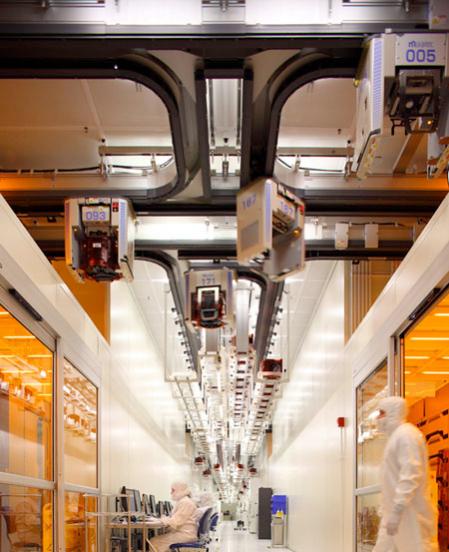A modern fab can cost as much as $10B dollars. That’s billion with a B. Since it has a lifetime of perhaps 5 years, owning a fab costs around $50 per second and that’s before you buy any silicon or chemicals or design any chips. Obviously anyone owning a fab had better be planning on making and selling a lot of chips if they are going to make any money. A modern fab manufactures over 50,000 dinner-plate sized wafers every month.
In the past, fabs were cheaper. As a result most semiconductor companies owned their own fabs. In fact around 1980 there were no semiconductor companies that didn’t own their own fabs since there would be no way for them to manufacture their designs.
The first thing that happened was that some companies found they had excess capacity in their own fabs because an economically large fab might turn out to be larger than their own needs for their own product lines. Correspondingly, other companies may have the opposite problem: they didn’t build a big enough fab or they were late constructing it, and they could sell more product than they could manufacture.
So semiconductor companies would buy and sell wafers from each other to even out their capacity needs. This was known as foundry business, analogous to a steel foundry. In a similar way, semiconductor companies with shortages would take their designs to other semiconductor companies with surplus capacity (often even competitors) and have them manufactured for them.
The next step in the evolution of the ecosystem was that in the mid-1980s some companies realized that they didn’t need to own a fab to have chips manufactured. These companies would purchase foundry wafers just like any other semiconductor company. These companies came to be called, for obvious reasons, fabless semiconductor companies. Two of the earliest were Chips and Technologies, who made graphics chips for the PCs of the day and Xilinx who made what are now known as field-programmable gate-arrays (FPGAs). They purchased wafers from other semiconductor companies and sold them just as if they’d manufactured them themselves. Chips and Technologies eventually was acquired after falling on hard times, but Xilinx is still the leader in FPGAs today. And despite being number one, it still doesn’t have its own fab, it outsources all manufacturing.
Semiconductor companies with fabs became known as integrated device manufacturers, or IDMs, to distinguish them from the fabless companies. In 1987 the first of another new breed of semiconductor companies was created with the founding of Taiwan Semiconductor Manufacturing Company (TSMC). TSMC was the first foundry, created only to do foundry business for other companies who needed to purchase wafers either because they were fabless or because they were capacity limited. It was also known, when the distinction was important, as a pure-play foundry to distinguish it from IDMs selling excess capacity who would often be competing at the component level with their foundry customers.
Until TSMC and its competitors came into existence, getting a semiconductor company off the ground was difficult and expensive. To build an IDM required an expensive fab. To build a fabless semiconductor company required a complicated negotiation for excess foundry capacity at a friendly IDM which might go away if the IDM switched from surplus to shortage as its business changed. Once TSMC existed, buying wafers was no longer a strategic partnership, you just gave TSMC an order.
This lowered the cost and the risk of creating a semiconductor company and during the 1990s, many fabless semiconductor companies were funded by Silicon Valley venture capitalists. Historically, a semiconductor company had to be large since it had to have enough business to fill its fab. Now a semiconductor company could have just a single product, buy wafers or finished parts from TSMC and sell them.
Over time, another change happened. Many system companies also switched from using the ASIC companies to doing their designs independently and then buying wafers from the foundries. The specialized knowledge about how to design integrated circuits that was lacking in the system companies in the 1980s was gradually acquired and by the 1990s many system companies had very large integrated circuit design teams. The ASIC companies gradually started selling more and more of their own products until they became, in effect, IDMs.
As fabs got more expensive, another change happened. IDMs such as Texas Instruments and AMD that had always had their own fabs found they could no longer afford them. Instead some switched to being completely fabless. For example, AMD sold its fabs to an investment consortium that turned it into a foundry called Global Foundries. Alternatively they kept their own fabs for some of their capacity and purchased additional capacity, typically in the most advanced processes, externally. This was known as fab-lite.
This is the landscape today. There are a few IDMs such as Intel who build almost all of their own chips in their own fabs. There are foundries such as TSMC and Global Foundries who build none of their own chips, they just build wafers for other companies. Then there are fabless semiconductor companies such as Xilinx and Qualcomm along with their fab-lite brethren such as Texas Instruments, who do their own design, sell their own products, but use foundries for all or part of their manufacturing.
A Brief History of Semiconductors
A Brief History of ASICs
A Brief History of Programmable Devices
A Brief History of the Fabless Semiconductor Industry
A Brief History of TSMC
A Brief History of EDA
A Brief History of Semiconductor IP
A Brief History of SoCs








Quantum Computing Technologies and Challenges